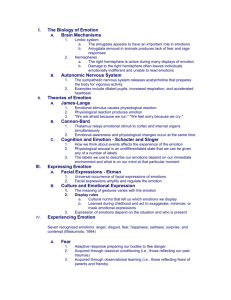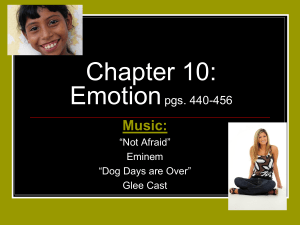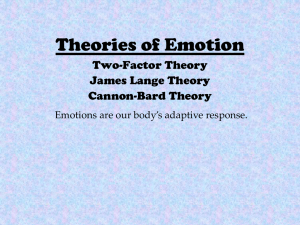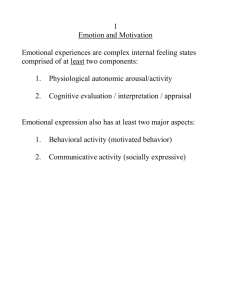Emotions and Stress Chapter 12 Lecture 13
advertisement
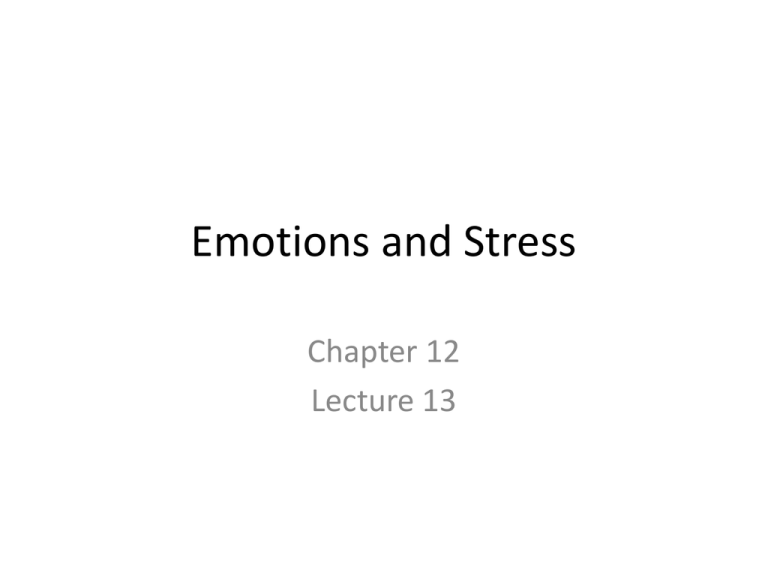
Emotions and Stress Chapter 12 Lecture 13 Emotions • Feelings that generally have both physiological and cognitive elements and that influence behavior • Physiological – Sympathetic = “fight or flight” response The Functions of Emotions • Preparing us for action • Shaping our future behavior • Helping us interact more effectively with others Theories of Emotion Emotions are a mix of 1) physiological activation, 2) expressive behaviors, and 3) conscious experience. 4 Controversy 1) Does physiological arousal precede or follow your emotional experience? 2) Does cognition (thinking) precede emotion (feeling)? 5 Commonsense View When you become happy, your heart starts beating faster. First comes conscious awareness, then comes physiological activity. Bob Sacha 6 James-Lange Theory 7 Cannon-Bard Theory 8 Two-Factor Theory 9 Physiological Similarities Physiological responses related to the emotions of fear, anger, love, and boredom are very similar. M. Grecco/ Stock Boston Excitement and fear involve a similar physiological arousal. 10 Physiological Differences Physical responses, like finger temperature and movement of facial muscles, change during fear, rage, and joy. The amygdala shows differences in activation during the emotions of anger and rage. Activity of the left hemisphere (happy) is different from the right (depressed) for emotions. 11 Which parts of the brain process emotions? Phan 2002 Cognition and Emotion What is the connection between how we think (cognition) and how we feel (emotion)? Can we change our emotions by changing our thinking? 13 Cognition Can Define Emotion An arousal response to one event spills over into our response to the next event. Reuters/ Corbis AP Photo/ Nati Harnik Arousal from a soccer match can fuel anger, which may lead to rioting. 14 Cognition Does Not Always Precede Emotion When fearful eyes were subliminally presented to subjects, fMRI scans revealed higher levels of activity in the amygdala (Whalen et al. 2004). Courtesy of Paul J. Whalen, PhD, Dartmouth College, www.whalenlab.info 15 Expressed Emotion Which aspects of emotional expression are universal and which depend on the culture? 16 Detecting Emotion • What emotion are most people good at recognizing in facial expressions? • What are most people bad at recognizing using facial expression? 17 Detecting Emotion Dr. Paul Elkman, University of California at San Francisco Which of Paul Ekman’s smiles is genuine? 18 Gender, Emotion, and Nonverbal Behavior 19 The Effects of Facial Expression Courtesy of Louis Schake/ Michael Kausman/ The New York Times Pictures Attaching two golf tees to the face and making their tips touch causes the brow to furrow. 20 Causes of Anger 1. People generally become angry with friends and loved ones who commit wrongdoings, especially if they are willful, unjustified, and avoidable. 2. People are also angered by foul odors, high temperatures, traffic jams, and aches and pains. 21 Catharsis Hypothesis Venting anger through action or fantasy achieves an emotional release or “catharsis.” Expressing anger breeds more anger, and through reinforcement it is habit-forming. 22 Cultural & Gender Differences 1. 2. 3. Boys respond to anger by moving away from that situation, while girls talk to their friends or listen to music. Anger breeds prejudice. The 9/11 attacks led to an intolerance towards immigrants and Muslims. The expression of anger is more encouraged in cultures that do not promote group behavior than in cultures that do promote group behavior. Wolfgang Kaehler 23 What makes people happy? Emotional Ups and Downs Over the long run, our emotional ups and downs tend to balance. Although grave diseases can bring individuals emotionally down, most people adapt. Courtesy of Anna Putt 25 Wealth and Well-being Many people in the West believe that if they were wealthier, they would be happier. However, data suggests that they would only be happy temporarily. 26 Wealth and Well-being 1. In affluent societies, people with more money are happier than people who struggle for their basic needs. 2. People in rich countries are happier than people in poor countries. 3. A sudden rise in financial conditions makes people happy. However, people who live in poverty or in slums are also satisfied with their life. 27 Happiness & Prior Experience Adaptation-Level Phenomenon: Like the adaptation to brightness, volume, and touch, people adapt to income levels. “Satisfaction has a short half-life” (Ryan, 1999). 28 Happiness & Satisfaction Subjective well-being (happiness + satisfaction) measured in 82 countries shows Puerto Rico and Mexico (poorer countries) at the top of the list. 29 Values & Life Satisfaction Students who value love more than money report higher life satisfaction. 30 Happiness & Others’ Attainments Happiness is not only relative to our past, but also to our comparisons with others. Relative Deprivation is the perception that we are relatively worse off than those we compare ourselves with. 31 Predictors of Happiness Why are some people generally more happy than others? 32 Stress and Stressors Stress is not merely a stimulus or a response. It is a process by which we appraise and cope with environmental threats and challenges. Bob Daemmrich/ The Image Works When short-lived or taken as a challenge, stressors may have positive effects. However, if stress is threatening or prolonged, it can be harmful. 33 Health-Related Consequences Kathleen Finlay/ Masterfile Stress can have a variety of health-related consequences. 34 EPA/ Yuri Kochetkov/ Landov General Adaptation Syndrome 35 Stress and the Heart Stress that leads to elevated blood pressure may result in coronary heart disease, a clogging of the vessels that nourish the heart muscle. Plaque in coronary artery Artery clogged 36 Reducing stress Aerobic Exercise 38 Biofeedback, Relaxation, and Meditation Biofeedback ,Relaxation and Meditation 39 Life-Style Modification Ghislain and Marie David De Lossy/ Getty Images Modifying a Type-A lifestyle may reduce the recurrence of heart attacks. 40 Spirituality & Faith Communities 41 Intervening Factors Investigators suggest there are three factors that connect religious involvement and better health. 42 My own research during graduate school • Emotion and working memory • Emotion regulation Memoranda (1.2s each face) Working memory task Fixation (0.5s) + Cue (1s) IAPS Distracters: Neutral or Unpleasant (4s) Respond Naturally Fixation (1.5s) + Probe (1.5s) Fixation (12.5s) At probe they were to answer the question: Which of the two faces was in the memoranda you just saw? +
